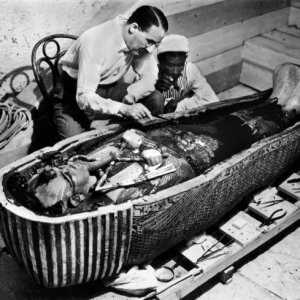 6
6




 30. 12. 2021
30. 12. 2021

Archaeologist Howard Carter made another remarkable discovery three years after finding King Tut's intact tomb in the Valley of the Kings. In 1925, Carter came across two daggers hidden in a cloth wrapped around Tutankhamun's mummified body. Almost a century later, it was confirmed that the blade of one of the daggers is made of a material that comes from a meteorite.
A dagger made of "iron" with a decorated gold handle was found on King Tut's right thigh. The blade of this dagger was encapsulated in a golden scabbard decorated with a pattern of feathers, lilies and a jackal's head. The second blade was found near King Tut's belly and was made entirely of gold.

Howard Carter examines King Tutus' golden sarcophagus in Egypt, 1922. (Photo Credit: Apic / Getty Images)
At the time of King Tut's death and subsequent mummification around 1323 BC (Bronze Age), iron smelting was extremely rare. Ancient Egypt was rich in various mineral resources, including copper, bronze and gold - all used since the fourth millennium BC. On the other hand, the practical use of iron in Egypt occurred much later in the country's history, with the earliest mentions of iron smelting dating back to the first millennium BC. Therefore, the rarity of iron at the time King Tut was buried means that the iron dagger hidden on his body was more valuable than gold.
Since the third millennium BC (the time of King Tut's death), a minimum number of iron objects have been found in Egypt. Most archaeologists believe that a handful of iron objects dating to this time period were probably made of meteoric metal. In fact, iron was so prized during this era that the ancient Egyptians referred to metal as "iron coming from heaven."
Studies conducted in the 70s and 90s determined that the blade most likely came from a meteorite, but these findings were inconclusive. In 2016, advanced technology allowed experts to review the composition of the blade and perform new tests to find out once and for all whether the iron really came from a meteorite. A team of experts compared the composition of the dagger with meteorites that landed within 1250 miles and found that the composition of iron was "almost identical" to the composition of a meteor found in the port city of Marsa Matruh. It is located 250 miles west of Alexandria.
The scientists believe that this dagger was a royal gift, which was probably given to King Tutus. Diplomatic documents from the Egyptian royal archives from the 14th century BC (known as Amarna letters) mention royal gifts made of iron in the period just before Tutus' reign. Specifically, it is said that Tushratta, King Mitanni, sent iron objects to Amenhotep III, who is believed to be potentially the grandfather of Tutankhamun. This list also mentions daggers with an iron blade and an iron bracelet on his hand.
The authors, GFL Stanglmeier and André Liebe, dispel Egyptological myths and discover unsuspected connections between ancient Egypt and the advanced world. The myths of Usir (Osiris) have accompanied Egyptology for ages. His head was and still is wanted in the Egyptian city of Abydos. The author duo GFL Stanglmeier and André Liebe have been searching for all traces of the mysterious god of death since 1999. But who really was Usir? The king of the early ages, one of the ancient idols, the most powerful deity of all time, or an astronaut who visited our planet thousands of years ago?